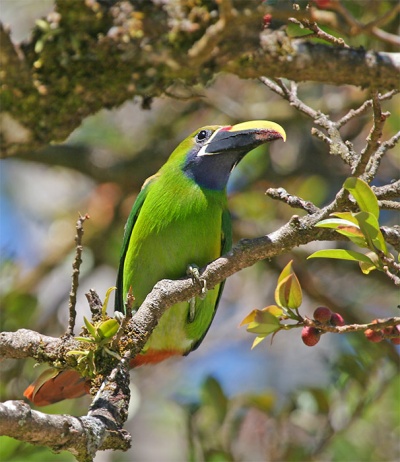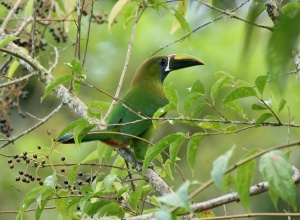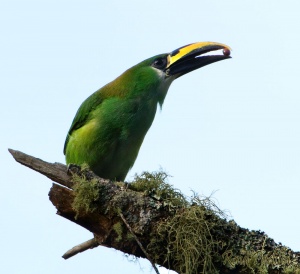| Line 3: | Line 3: | ||
'''Includes: Blue-throated Toucanet; Violet-throated Toucanet; Wagler's Toucanet''' | '''Includes: Blue-throated Toucanet; Violet-throated Toucanet; Wagler's Toucanet''' | ||
==Identification== | ==Identification== | ||
| − | 30-35cm (11¾-13¾ in). | + | 30-35cm (11¾-13¾ in). Sexes similar but females have shorter bills. |
*Green plumage | *Green plumage | ||
*Rufous vent and tail tip | *Rufous vent and tail tip | ||
| Line 18: | Line 18: | ||
* ''caeruleogularis'' group with blue throat | * ''caeruleogularis'' group with blue throat | ||
* ''cognatus'' with violet throat | * ''cognatus'' with violet throat | ||
| − | + | Some sources describe throat color as violet-blue in both of the last two forms. | |
| − | |||
==Distribution== | ==Distribution== | ||
Revision as of 01:26, 26 April 2018

Photo by: Reini
Monteverde, Costa Rica, February 2005
- Aulacorhynchus prasinus
Includes: Blue-throated Toucanet; Violet-throated Toucanet; Wagler's Toucanet
Identification
30-35cm (11¾-13¾ in). Sexes similar but females have shorter bills.
- Green plumage
- Rufous vent and tail tip
- Black bill with yellow on the upper mandible
- White, yellowish, violet or blue throat dependent on subspecies
- Eye ring can be blue to red
- Dull grey legs
- Dark iris
Variations
The subspecies vary in extent of black on bill, in colour of basal line of bill, in colour around eye, throat colour, and tone of green around breast and head:
- wagleri with yellower crown and pale breast with blue tinge
- prasinus group with yellow on upper mandible more extensive than any other group - reaching base of upper mandible and as a stripe at base of lower mandible, black around nares, whitish or yellowish wash on throat, and white below eyes
- caeruleogularis group with blue throat
- cognatus with violet throat
Some sources describe throat color as violet-blue in both of the last two forms.
Distribution
Found from southern Mexico south to Panama and nearest part of Colombia
Locally common in parts of its range.
Taxonomy
Formerly considered conspecific with Southern Emerald Toucanet under the name Emerald Toucanet. Gill and Donsker further split this species into Wagler's Toucanet, Emerald Toucanet, and Blue-throated Toucanet (caeruleogularis including maxilliaris and cognatus).
Subspecies
Clements recognizes 8 subspecies in four groups[2]:
- Wagler's Toucanet:
- A. p. wagleri - in Sierra Madre del Sur of south west Mexico (Guerrero and south-western Oaxaca)
- Emerald Toucanet:
- A. p. prasinus - in south east Mexico (Veracruz, adjacent San Luis Potosí and Oaxaca)
- A. p. warneri - in the mountains of south east Mexico (Sierra de Los Tuxtlas in southern Veracruz)
- A. p. virescens - southeastern Mexico, Guatemala, Belize, western El Salvador, Honduras, and northern Nicaragua
- A. p. volcanicus - in eastern El Salvador (Volcán San Miguel)
- Blue-throated Toucanet:
- A. p. caeruleogularis - Highlands of western Panama (Chiriquí to Coclé) (includes maxillaris according to IOC)
- A. p. maxillaris - Highlands of Costa Rica and western Panama
- Violet-throated Toucanet
Habitat
Open woodland and humid forest.
Behaviour
Diet
Their diet consists mostly of fruit, but some insects, lizards, and bird eggs are also taken. Forages usually singly, sometimes in groups.
Breeding
Breeding generally from March to July, locally starting in February and lasting to November. They nest in an unlined cavity in a tree; 3-4 white eggs are laid and incubated by both sexes for 14–15 days. Both parents care for the young which fledge after about 6 weeks.
References
- Del Hoyo, J, A Elliot, and J Sargatal, eds. 2002. Handbook of the Birds of the World. Volume 7: Jacamars to Woodpeckers. Barcelona: Lynx Edicions. ISBN 978-8487334375
- Clements, J. F., T. S. Schulenberg, M. J. Iliff, D. Roberson, T. A. Fredericks, B. L. Sullivan, and C. L. Wood. 2017. The eBird/Clements checklist of birds of the world: v2017, with updates to August 2017. Downloaded from http://www.birds.cornell.edu/clementschecklist/download/
- Gill, F and D Donsker (Eds). 2016. IOC World Bird Names (version 6.4). Available at http://www.worldbirdnames.org/.
Recommended Citation
- BirdForum Opus contributors. (2024) Northern Emerald Toucanet. In: BirdForum, the forum for wild birds and birding. Retrieved 16 April 2024 from https://www.birdforum.net/opus/Northern_Emerald_Toucanet





